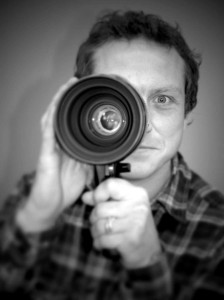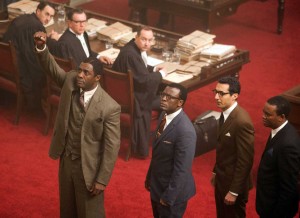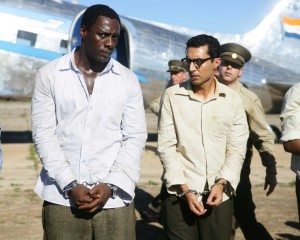
Cinematographer Lol Crawley, BSC, moves easily between film and digital when shooting features and television series that have included Four Lions, Ballast and The Crimson Petal and the White. His latest project, Mandela: Long Walk to Freedom, was shot on film, a format he prefers and said was well suited to the epic scope of Nelson Mandela‘s story. “[Director] Justin [Chadwick] saw it as a film entirely on 35 mm, though we originally explored shooting some sections in 16,” said Crawley by telephone from London. “When you shoot on film I think there is definitely a difference, though, sadly, it’s becoming harder and harder to articulate what that difference is.”
He and Chadwick spoke early on about embracing Mandela “warts and all,” he said. “We wanted to avoid portraying him with a saintly kind of reverence, so we looked for ways to show, with a certain visual rawness, how he had evolved over the years, made mistakes that led to his imprisonment, but how he had moved beyond the violence. We used handheld cameras whenever possible and tried to embrace available light.”

Mixing sweeping Steadicam shots with those edgier handheld styles, the film was recorded on a combination of 50, 250 and 500 ASA Kodak stocks. “We decided that through different uses of film stock and obviously through the final grade, we would be able to create the decades of Mandela’s life,” Crawley said. “We did a lot of testing beforehand on Fuji and Kodak, as well as mixtures of both, but those three worked well together, particularly across the range of setups.”
The film’s most dramatic handheld sequences include the pivotal Sharpeville massacre scene and the moment Winnie Mandela learns of her husband’s arrest. “We knew early on we wanted to have a kind of City of God (2002) handheld energy to lend an immediate, energized POV to that scene as the camera races through the streets of Soweto to catch her emotional reaction,” he said.
 Crawley is most guided behind the lens by understanding how the elements align in the particular moment of the shoot. He also credits production designer Johnny Breedt with some of the “most powerful environments” he’s ever shot in. “I always try to respond to what’s there, whether that’s a location, a fabulous set, a time of day or a performance, and try not to impose too much.” He cited the magic-hour light of the Transkei, Mandela’s childhood home, as an example. “When you find yourself in these massive, expansive landscapes, where the light is just ever-present and the sky goes on forever, you really don’t have to do a huge amount and you have to trust that.”
Crawley is most guided behind the lens by understanding how the elements align in the particular moment of the shoot. He also credits production designer Johnny Breedt with some of the “most powerful environments” he’s ever shot in. “I always try to respond to what’s there, whether that’s a location, a fabulous set, a time of day or a performance, and try not to impose too much.” He cited the magic-hour light of the Transkei, Mandela’s childhood home, as an example. “When you find yourself in these massive, expansive landscapes, where the light is just ever-present and the sky goes on forever, you really don’t have to do a huge amount and you have to trust that.”
By contrast, “the built up, bustling, conflicted and divided white and black city” of Johannesburg, where Mandela begins his career, “has a very different sense of light, as did the townships where he lived,” he said. “There was not a lot of electrical light in the streets of those places at the time, so I wanted to be faithful to that history of lower light. We needed to be brave enough to embrace silhouettes and give the audience credit for knowing the characters well enough at this point not to have to light every single face. That would have been unnatural, given the setting.”
Crawley’s shooting style is also story driven as much as it is determined by environment. “For me, it is about having a shooting style and lighting approach that can be a little more fluid and flexible so it is open to what happens on set. I always try to look out for the accidental and unplanned, which I think is a much more interesting type of filmmaking.”





